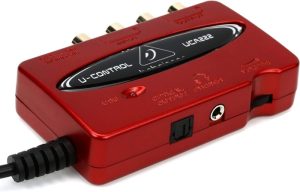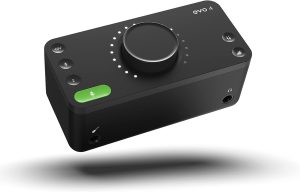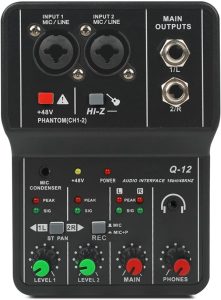Compact audio interfaces are indispensable tools for musicians and podcasters who prioritize top-notch sound quality in a portable package. Perfect for both home studios and on-the-go recording sessions, these devices streamline the process of capturing and playing back audio by linking microphones and instruments to computers. With various input and output options and advanced digital conversion capabilities, the finest compact audio interfaces effortlessly blend functionality with convenience, guaranteeing professional-level audio production wherever you are.
To aid you in making the best choice, we’ve thoroughly evaluated the following key parameters:
- Input and Output Options: We’ve carefully examined the range and quality of input and output choices offered by each interface. This includes assessing the number of mic preamps, line inputs, and headphone outputs available, catering to individual projects as well as collaborative endeavors.
- Audio Quality: At the heart of every audio interface lies its ability to deliver crystal-clear sound. Our rigorous testing process involves evaluating recording and playback quality to ensure that each interface delivers clear, low-noise recordings. We’ve paid special attention to the converters and preamps utilized, as these components significantly impact overall audio fidelity.
- Phantom Power: Considering the widespread use of condenser microphones in music production and podcasting, the presence of phantom power was a crucial consideration. This essential feature enables users to connect a broader range of microphones, thereby enhancing the interface’s versatility and the quality of recordings.
In your search for a compact audio interface, it’s vital to take these three essential factors into account. Additionally, we recommend reviewing the provided “Buying Guide” below for further assistance.
Outline
ToggleBest Small Audio Interfaces List
| Best Small Audio Interfaces | Input and Output | Audio Quality Resolution | Phantom Power | Buy Now |
|---|---|---|---|---|
| Behringer Small Audio Interface | 2 x 1/4" TRS (Balanced) S/PDIF Optical | 16-bit/48kHz | - | Check On Amazon |
| Universal Audio Small Audio Interface | 2-in/2-out USB, XLR and ¼” (6.35 mm) TRS plugs, 1 headphone output | 24-bit/192 kHz | 48V | Check On Amazon |
| ARTURIA Small Audio Interface | 1x Combo Mic/Inst/Line XLR inputs, 2x Inst/Line TRS inputs 1/4" TRS balanced line outputs | 24-bit/192 kHz | 48V | Check On Amazon |
| Audient Small Audio Interface | - | 24bit/96kHz | +48V | Check On Amazon |
| XTUGA Small Audio Interface | 3-pin XLR socket, 3.5mm jack | 16-bit/48 kHz | 48V | Check On Amazon |
Best Small Audio Interfaces Reviews
1. Behringer Small Audio Interface
The Behringer Audio Interface is a compact solution for transferring analog audio to digital format while maintaining high-quality sound. It’s designed for ease of use, allowing musicians, podcasters, and audio engineers to connect a wide range of equipment to their computers without the need for complex setups or external power sources.
The interface is powered directly from the USB bus, making it ideal for mobile recording setups. The UCA222 offers straightforward connectivity with two analog mono inputs and outputs, plus additional digital output for direct analog-to-digital conversion. This device is not just about connectivity; it comes packed with a vast array of software to enhance your recording and production capabilities, including the versatile Audacity audio editor and over 150 virtual instruments and effect plugins.
| Technical Specifications | Description |
| Analog Inputs | 2 x 1/4″ TRS (Balanced) |
| Analog Outputs | 2 x RCA (Unbalanced), 1 x 1/8″ (Headphone) |
| Digital Output | S/PDIF Optical |
| MIDI Ports | In/Out |
| Audio Quality | 16-bit, 48 kHz (A/D and D/A Conversion) |
| Preamps | 2 Built-In Preamps |
| Compatibility | PC and Mac |
| Connectivity | USB 2.0 (USB 1.1 Compatible) |
| Supported Software | Audacity Audio Editor, Podcasting Software,
Bundled Virtual Instruments and Plug-Ins |
| Weight | 0.2 lbs (0.1 kg) |
Pros
- Plug-and-play functionality with both PC and Mac, requiring no additional drivers.
- The inclusion of a massive software bundle adds incredible value, offering tools for recording, editing, and adding effects.
- Compact and portable design, ideal for musicians and podcasters on the go.
- Offers a straightforward solution for transferring analog audio to digital format without compromising on sound quality.
Cons
- Some compatibility issues and mixed opinions on sound quality, indicating that it may not meet the needs of more demanding audio tasks.
2. Universal Audio Small Audio Interface
The Universal Audio Volt 2 USB Audio Interface sets a new standard for compact, high-quality audio interfaces. With its class-leading 24-bit/192 kHz audio conversion, the Volt 2 ensures your recordings are captured with pristine clarity and detail.
One of its standout features is the Vintage Mic Preamp mode, which emulates the iconic Universal Audio 610 tube preamp, providing recordings with a rich, full sound characteristic of some of the most legendary recordings in music history. This interface doesn’t just excel in audio quality; it’s also designed for ease of use, offering seamless integration with Mac, PC, iPad, and iPhone, and comes bundled with industry-leading software to kickstart your production process.
| Technical Specifications | Description |
| Supported Software | Ableton, Melodyne, Virtual Drummer, Marshall, Ampeg |
| Connectivity Technology | USB |
| Number of Channels | 2 |
| Audio Resolution | 24-bit/192 kHz |
| Preamp | Vintage Mic Preamp mode (UA 610 tube preamp) |
| Phantom Power | 48V |
| Headphone Amp | Studio-quality |
| Compatible Devices | Mac, PC, iPad, iPhone |
Pros
- The Vintage Mic Preamp mode offers unique sound quality that emulates high-end vintage gear, making it stand out in its class.
- Superior audio conversion ensures every detail of your recording is captured with utmost clarity.
- The inclusion of a wide range of professional software extends its value and use right out of the box.
- USB bus power and compatibility across devices make it a versatile option for recording on the go.
Cons
- Some issues with a hum noise in specific setups, which could be a drawback for critical recording sessions.
3. ARTURIA Small Audio Interface
Arturia claims the third position in our list of the top small audio interfaces amidst a crowded market of compact USB audio interfaces. The MiniFuse 1 boasts an unmatched blend of sound excellence, sturdy construction, and an extensive warranty. Tailored for musicians, vocalists, and content creators alike, this device guarantees that each recording captures the authentic essence of the sound origin, courtesy of its top-notch preamps and converters.
Beyond merely capturing sound, this interface strives to streamline and enhance the recording experience. Its compact form factor, user-friendly functionalities, and seamless compatibility with both PCs and Macs make the MiniFuse 1 an ideal selection for those seeking to generate top-tier audio, whether within the confines of home studios or amidst outdoor settings. Furthermore, it comes equipped with an array of creative software, rendering it a comprehensive solution for individuals embarking on their music production voyage.
| Technical Specifications | Description |
| Connectivity Technology | USB-C |
| Number of Channels | 2 |
| Inputs | 1x Combo Mic/Inst/Line XLR inputs with 48V phantom power, 2x Inst/Line TRS inputs |
| Outputs | 1/4″ TRS balanced line outputs |
| MIDI Input & Output Connections | 5-pin MIDI |
| Audio Quality | Studio-grade quality |
| Construction | Rugged aluminum casing |
| Compatibility | PC and Mac |
| Software Included | Ableton Live Lite, Analog Lab Intro, Arturia FX, NI GUITAR RIG 6 LE, Auto-Tune Unlimited, Splice Creator Plan |
Pros
- The 5-year warranty and robust build quality offer peace of mind and durability for long-term use.
- A comprehensive software bundle provides tools for immediate music production, enhancing the overall value.
- High-quality sound specifications ensure clear and detailed recordings, suitable for professional projects.
- Its compact and portable design makes it ideal for creators on the go, without compromising on connectivity and quality.
Cons
- Some bass-heavy recordings, may require additional EQ adjustments for clarity.
4. Audient Small Audio Interface
The Audient EVO 4 USB Audio Interface redefines what one can expect from a compact interface with its innovative features and superior sound quality. Crafted to simplify the recording process while delivering professional-grade audio, the EVO 4 is perfect for musicians, podcasters, and audio engineers alike. It introduces the Smartgain feature, automatically setting levels for optimal sound capture, ensuring your recordings are clear and consistent.
Backed by Audient’s 25 years of engineering expertise, this interface boasts high-performance converters and two studio-grade preamps, capturing every detail with exceptional clarity. Its intuitive design, including a multifunctional rotary control and smart touchpoints, allows for easy operation, making it an excellent choice for both beginners and seasoned professionals. Whether you’re recording at home or on the move, the EVO 4’s compact size and USB-powered design offer unparalleled flexibility and convenience.
| Technical Specifications | Description |
| Supported Software | iOS (requires USB hub that can be powered) |
| Connectivity Technology | USB |
| Number of Channels | 2 |
| Compatible Operating Systems | MacOS, Windows, iOS (via powered USB hub) |
| Microphone Preamps | 2 x EVO |
| Converter/Sample Rate | 24-bit/96kHz |
| Free Software & Plug-in Package | Included |
| Weight | 360 grams |
Pros
- Smartgain feature significantly simplifies the recording process, making it easier to achieve professional results.
- Exceptional audio quality with high-performance converters and preamps ensures recordings are true to source.
- Intuitive design with smart touchpoints and multifunctional rotary control enhances the user experience.
- Compact and USB-powered, it’s ideal for mobile recording setups without compromising on sound quality.
Cons
- Some issues with crackling noises during quiet passages, which could disrupt recording sessions.
5. XTUGA Small Audio Interface
The XTUGA USB Audio Interface serves as an excellent entry-level solution. Engineered for simplicity, it offers a hassle-free plug-and-play experience, eliminating the usual complexities associated with audio interfaces. Despite its budget-friendly price, the XTUGA interface doesn’t compromise on crucial features, delivering 48V phantom power for condenser microphones and a high-performance converter that guarantees clear and distinct recordings at up to 16-bit/48 kHz resolution.
Its small, lightweight design makes it ideal for mobile creators, and the inclusion of a gain halo meter ensures optimal volume levels while recording. Whether you’re capturing vocals, guitars, or streaming content, this interface offers a straightforward and effective method to achieve top-notch audio quality without requiring extensive setup or technical expertise.
| Technical Specifications | Description |
| Connectivity Technology | USB |
| Number of Channels | 2 |
| Microphone Inputs | XLR with +48V Phantom Power |
| Additional Microphone Input | 3.5mm Jack |
| Audio Resolution | 16-bit/48 kHz |
| Compatibility | Compatible with Mainstream Audio Software |
| Weight | Lightweight |
Pros
- The super budget-friendly price makes it accessible to beginners and those on a tight budget.
- Easy plug-and-play functionality suits users looking for a straightforward setup without the hassle of drivers or complicated configurations.
- Compact and portable design enables on-the-go recording and streaming, ideal for mobile creators.
- Provides essential features like 48V phantom power, making it suitable for a wide range of microphones and recording needs.
Cons
- Limited audio resolution (16-bit/48 kHz) may not meet the needs of more advanced users looking for higher fidelity recordings.
Buying Guide for Best Small Audio Interfaces for Aspiring Musicians
When selecting the best small audio interfaces, it is important to consider several key factors that directly impact your recording experience and the quality of your projects. Below, we outline these critical aspects, why they matter, and what to look for in each category.
1. Input and Output Options
Why It Matters: The variety and number of inputs and outputs determine how many instruments, microphones, and external devices you can connect simultaneously. This versatility is crucial for accommodating various recording situations, whether you’re capturing a live performance, podcasting, or producing music.
What to Look For: Seek interfaces with a balanced number of input and output options, including XLR and 1/4″ inputs for microphones and instruments, as well as headphone and monitor outputs. For those planning to record multiple sources at once, ensure the interface has enough inputs to support your needs. Additionally, consider interfaces that offer MIDI I/O for connecting synthesizers, drum machines, and other MIDI gear.
2. Audio Quality
Why It Matters: High audio quality is essential for producing professional recordings. The clarity, depth, and accuracy of the audio captured can significantly impact the final product. An interface with superior audio quality will ensure that recordings are true to the original source, providing a solid foundation for mixing and mastering.
What to Look For: Focus on interfaces with high-resolution AD/DA converters, capable of capturing and reproducing sound at professional bit depths and sample rates (at least 24-bit/48kHz, though higher rates like 96kHz or even 192kHz are preferable for more demanding projects). Pay attention to the noise level and dynamic range specifications, as these will affect the clarity and detail of your recordings.
3. Phantom Power Voltage
Why It Matters: Phantom power is required to operate condenser microphones, which are widely used for their sensitivity and audio quality. The presence of reliable phantom power ensures that these microphones perform optimally, capturing detailed and nuanced recordings.
What to Look For: Ensure the audio interface provides standard 48V phantom power. This is critical for compatibility with a wide range of condenser microphones. Some interfaces may offer variable voltage options, but 48V is the industry standard and is necessary for most condenser mics.
4. Digital Connectivity
Why It Matters: Digital connectivity options such as USB, Thunderbolt, and FireWire determine how the interface connects to your computer, affecting data transfer speed, latency, and overall workflow efficiency. The right type of connectivity can enhance the recording experience by providing faster data rates and lower latency, making real-time monitoring and high track counts more manageable.
What to Look For: Choose an interface that is compatible with your computer’s ports and supports your workflow needs. USB interfaces are widely compatible and sufficient for many users, but those requiring lower latency and higher data throughput might benefit from Thunderbolt or FireWire connections. Also, consider future-proofing your setup with interfaces that offer USB-C connectivity, as this is becoming the standard for new computers.
Best Small Audio Interfaces – FAQs
Ans: A small audio interface is a compact device for connecting audio equipment to a computer, suitable for smaller setups.
Ans: It depends on your needs; 1-2 channels are common for solo use.
Ans: Not all; check for phantom power when using condenser mics.
Ans: Preamps amplify input signals for quality recordings.
Ans: Yes, they’re compatible with DAW software.
Ans: They expand I/O options and connect to digital equipment.
Conclusion
Choosing the best small audio interface depends on your specific needs and budget. Here’s a quick breakdown of three top contenders:
For the Budget-Conscious Beginner
- Behringer Small Audio Interface: Packed with features for its price, it offers basic recording and playback for vocals, instruments, and even headphones. However, its plastic build and potential sound quality limitations might hold you back as you progress.
For the Versatile Creator
- Universal Audio Small Audio Interface: This interface shines with its excellent sound quality, built-in compressor, and vintage emulation, making it perfect for recording vocals, instruments, and podcasts. Its software bundle adds further value for creators.
For the Mobile Musician
- ARTURIA Small Audio Interface: Incredibly compact and bus-powered, this interface is ideal for on-the-go recording. Its versatile input options accommodate instruments and microphones, and it includes creative software for production.
Remember, the best interface depends on your individual needs and budget. Consider your recording goals, desired features, and budget to find the perfect match for your sonic journey!






